Hall of the Planets, Schloß Eggenberg
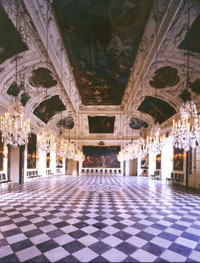 On the outskirts of Graz (Austria), built by Familia Eggenberg
a century before the residence at Würzburg that Tiepolo decorated, sits their
cosmological palace.
It is the symbolism and extensive allegory of this
elaborate estate and its decoration, rather than the family’s
political, social and economic circumstances, that will principally
occupy us here. Suffice it to say that a learned son,
in the second generation of the upwardly mobile
Eggenberg dynasty, designed and oversaw the execution of his own
cosmological plan, which was further implemented by generations of
powerful and wealthy descendents, only to suffer neglect finally
from their precipitous decline, brought about by a loss of the
family’s wealth and concomitant power.
On the outskirts of Graz (Austria), built by Familia Eggenberg
a century before the residence at Würzburg that Tiepolo decorated, sits their
cosmological palace.
It is the symbolism and extensive allegory of this
elaborate estate and its decoration, rather than the family’s
political, social and economic circumstances, that will principally
occupy us here. Suffice it to say that a learned son,
in the second generation of the upwardly mobile
Eggenberg dynasty, designed and oversaw the execution of his own
cosmological plan, which was further implemented by generations of
powerful and wealthy descendents, only to suffer neglect finally
from their precipitous decline, brought about by a loss of the
family’s wealth and concomitant power.
The exterior of Schloß Eggenberg, along with
its courtyard, were designed to be
unostentatious and utilitarian in the manner of the late
Renaissance palazzo fortificato, symbolic of the family’s
political and economic power and their superior moral bearing in
the community. Its decorations were likewise planned for moral
edification, keyed to virtues that had long since been codified in
antiquity, medieval tradition and the continental European
Renaissance.

Designs for the wall and
ceiling decorations of the Hall were
copied from emblem books and other illustrated ethical treatises.
The owner’s purpose, like that of his architect and court painter,
was to construct and embellish a four-square temple of virtue.
*
Our purpose is to contrast, implicitly, Schloß Eggenberg,
embellished with such a largely predictable system of myths,
legends and histories, of symbols, moral emblems and above all
allegories, with the more unpredictable and natural fluency of the
palace at Würzburg, whose design Tiepolo’s decorations implemented,
and, by extension, with the natural, dynamic, evolutionary allegory
of Madison Morrison’s Sentence of the Gods.
But first let us cite a few parallels and other similarities
between the structure, numerology and allegory of the earlier and
the later works, with emphasis not upon Tiepolo’s frescoes, which
the visitor may examine in digital reproductions and study with the
help of the notes provided on the originary web site, but rather
upon MM’s cosmological epic.
Ulrich von Eggenberg decreed that his palace be
symbolically comprehensive: its 365 windows correspond
to the number of days in the year, as does MM’s SOLUNA, with its
365 manuscript pages, which for him symbolize the Magnus Annum.
Sleep, the first book in the Sentence, and thus in
its solar and lunar phases, SOL and LUNA, has 52 pages; the Schloß
Eggenberg, 52 doors, the number corresponding to the number of
weeks in the year. As in SOLUNA, so in the Schloß, solar and lunar
symbolism is predominant. The four sides of the palace reflect the
rising sun and the midday sun, the rising moon of dusk and the
reigning moon of night. Other quaternions (the cardinal directions,
the seasons) are reflected in its four sides, as intermittently in
the major tetralogies of the Sentence: LUNA, ARES and
HERA.
Even the palace’s duodecimal features (details that number
twelve or multiples thereof, such as the twelve plus twelve details
of the inner courtyard that equal 24, or the 60 windows that form a
group within the 365) are echoed in such individual parts of
Sentence of the Gods as “Changes,” the tiny calendrical poem
in Sleep, or the first twelve poems of O, or the
twelve chapters of Revolution.
Likewise, Second
incorporates the 24 books of Homer’s Iliad and the 24 of his
Odyssey; Divine,
the twelve books of Vergil’s Aeneid. Unlike
Schloß Eggenberg, however, where the twelve signs of the zodiac
form a major part of its allegorical program, twelve is neither a
constant nor important number in the overall symbology of MM’s
universal epic, whose summative numbers are instead seven, eight
and nine.
The Hall of Planets at Graz depicts the seven heavenly bodies:
Sun,
Moon,
Mars,
Mercury,
Jupiter,
Venus and
Saturn, as
follows:
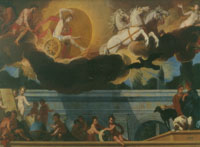
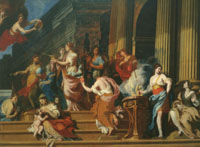
The Sun (for Sunday), followed by the remaining six planets and
their corresponding days.
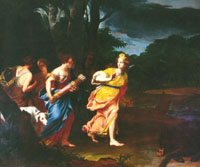
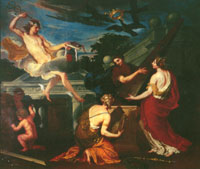
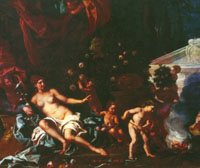
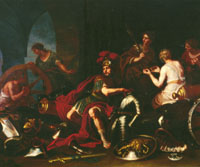
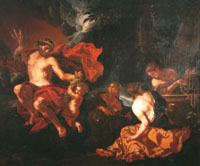
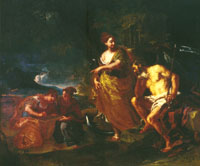
Click on the images above to enlarge them (again to enlarge them further) and
to pull up commentaries including interesting anecdotes about these divinities,
who correspond to the seven days of the week, if not to their precise sequence, as
in Sentence of the Gods. The court painter whom Ulrich employed emphasized a
permanent repertory of moral values, occasionally with considerable
critical sophistication, if not with unusual painterly skill (and
certainly with none of the imaginative genius of Giovanni Battista
Tiepolo).
Likewise Sentence of the Gods embodies the sun and the
moon and the five fixed stars or planets, plus the seven divinities
that govern them all:
SOL, LUNA, ARES, HERMES, HERA, APHRODITE,
EL
Though Madison Morrison is a highly ethical writer, here the
similarities between Ulrich’s palace and MM’s epic end. For the
decorator of the Hall of the Planets received from his patron a
commission to execute seven panels according to accepted
models, which he was free to imitate all at once. In
doing so he exercised considerable ingenuity and subtlety of
variation, but he neither invented nor departed from the plan that
he had received.
As MM’s account, in “An Extended Bio-Bibliography,” makes
clear his allegorical plan evolved quite differently. He began with
a first book, then a second, until the scheme for the first six
books emerged. Suddenly, in the midst of composing the seventh
book, a plan for all 26 books was given him by inspiration, but
only in its barest outline, not in its final richness of
allegorical detail. MM composed most of the first thirteen books in
the 26-book sequence consecutively; since this early period in the
epic’s development, however, he has jumped ahead to fill in books
of APHRODITE and EL, to reconceive Every
Second, and to
solve problems posed by the difficult book, Her, the first
in HERA/HERMES. It remains for him to complete the epic by moving
about to complete its remaining books.
In this process of composing Sentence of the Gods MM has
worked with “subtexts” and “pretexts,” with “intertexts” and
“hypertexts,” but unlike the court painter at Eggenberg he has
never literally traced a model. All his books are of his own
invention and so along with them, we might say, are the major
sequences of the Sentence, which have evolved and been
implemented according to a natural dynamic. (For “natural allegory”
see “Allegorical Details in the
Sentence.”) As important as “natural
allegory” is to MM’s method of composition, especially to its in
situ description, the dynamic process whereby the epic’s meaning is
modified as each new unit is superadded has perhaps even greater
importance. We await a mature scholar with a thorough grounding in
the allegorical tradition to elaborate this point.
 On the outskirts of Graz (Austria), built by Familia Eggenberg
a century before the residence at Würzburg that Tiepolo decorated, sits their
cosmological palace.
It is the symbolism and extensive allegory of this
elaborate estate and its decoration, rather than the family’s
political, social and economic circumstances, that will principally
occupy us here. Suffice it to say that a learned son,
in the second generation of the upwardly mobile
Eggenberg dynasty, designed and oversaw the execution of his own
cosmological plan, which was further implemented by generations of
powerful and wealthy descendents, only to suffer neglect finally
from their precipitous decline, brought about by a loss of the
family’s wealth and concomitant power.
On the outskirts of Graz (Austria), built by Familia Eggenberg
a century before the residence at Würzburg that Tiepolo decorated, sits their
cosmological palace.
It is the symbolism and extensive allegory of this
elaborate estate and its decoration, rather than the family’s
political, social and economic circumstances, that will principally
occupy us here. Suffice it to say that a learned son,
in the second generation of the upwardly mobile
Eggenberg dynasty, designed and oversaw the execution of his own
cosmological plan, which was further implemented by generations of
powerful and wealthy descendents, only to suffer neglect finally
from their precipitous decline, brought about by a loss of the
family’s wealth and concomitant power.







